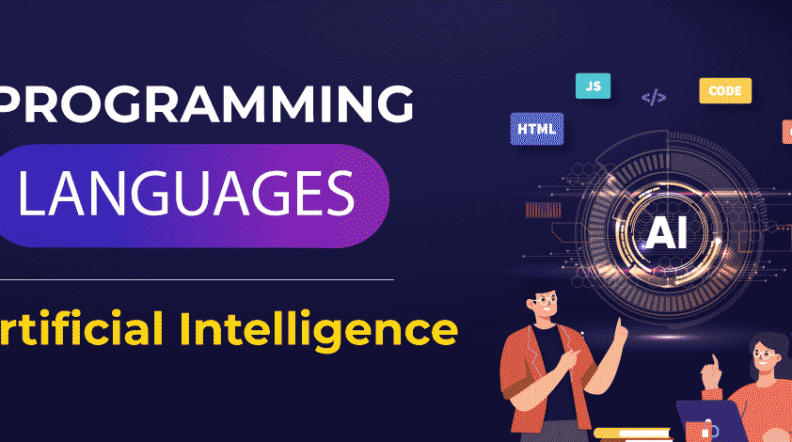Best Programming Language for AI: A Comprehensive Guide






Choosing the right programming language for artificial intelligence (AI) projects is pivotal, as it directly influences the speed and efficiency of development. Python, with its simplicity and flexibility, has emerged as a favorite among data scientists, especially for tasks such as statistical modeling and computer vision. Its extensive libraries like Keras further simplify the implementation of complex AI functionalities, making it an ideal choice for both beginners and seasoned professionals.
However, AI development isn’t confined to a single language. Java, known for its robustness, plays a critical role in mobile app development and enterprise solutions. Languages like Lisp and Prolog, though older, offer unique advantages in AI development, particularly in symbolic reasoning and logical programming. The choice of programming language often depends on the specific requirements of the AI application, be it data mining, self-driving cars, or deep neural networks.
Unveiling the Future of Technology: AI and Its Tools
Artificial Intelligence stands at the forefront of technological innovation, reshaping how we interact with digital systems. The tools and languages developed for AI pave the way for groundbreaking applications, from enhancing computer vision to advancing statistical modeling. As these technologies evolve, they promise to unlock new potentials across various sectors, including healthcare, automotive, and finance, heralding a new era of intelligent systems.
A Quick Dive Into Artificial Intelligence’s Evolution
The field of computer science has witnessed the rapidly growing domain of artificial intelligence, expanding its capabilities and applications. From its nascent stages of simple algorithms to the current advancements in deep learning and natural language processing, AI’s evolution reflects the increasing complexity and sophistication of the tasks it can perform, promising a future where AI is integral to solving some of the world’s most challenging problems.
From Past to Present: Tracing AI’s Journey
Tracing the journey of AI reveals a fascinating progression from theoretical concepts to real-world applications. Initially confined to research labs and academic papers, AI has now permeated every aspect of our lives, from the way we shop to the automation of complex industrial processes. This evolution, fueled by breakthroughs in algorithms and a significant increase in computational power, has made AI technologies more accessible and applicable across diverse fields.
The Significance of Programming Languages in AI Development
In the world of AI, the choice of programming language can significantly impact the development process. Programming languages serve as the medium through which ideas and algorithms are transformed into functional AI systems. They dictate the ease with which developers can implement complex AI models and directly affect the speed and efficiency of the development cycle. As such, selecting the right language is a crucial step in the journey of developing AI solutions.
How Languages Shape AI’s Capabilities
The capabilities of AI systems are deeply influenced by the programming languages used to develop them. Languages that offer a rich set of AI-specific libraries and frameworks allow developers to create more sophisticated and efficient AI models. For example, Python’s extensive support for deep learning and natural language processing enables the creation of advanced AI applications with relative ease. Meanwhile, the low-level language control provided by C++ can be crucial for applications where performance is paramount. Thus, the choice of language is instrumental in defining what AI can achieve.
The Leading AI Programming Languages: An In-Depth Look
An exploration into the leading programming languages for AI reveals a diverse landscape, each offering unique strengths. Python remains the frontrunner, celebrated for its extensive libraries and ease of use, making it the first choice among AI developers. However, languages like Java, Lisp, and Prolog continue to play significant roles, catering to specific needs within the AI development community. Understanding the nuances and capabilities of these languages is essential for anyone looking to delve into AI programming.
1. Python – The Lingua Franca of AI
Python’s dominance in the world of AI is undisputed. Its appeal lies in the combination of simplicity, extensive libraries and frameworks, and a supportive community of AI developers. This language facilitates the implementation of complex mathematical models and deep neural networks, making it the go-to choice for professionals and hobbyists alike. Python’s versatility allows it to cater to a wide range of AI applications, from machine learning to computer vision, solidifying its position as the lingua franca of AI.
Exploring Python’s Dominance in AI
The reasons behind Python’s dominance in AI are manifold. Its syntax is straightforward, which reduces development time and makes it accessible to newcomers. Moreover, the availability of libraries like Keras simplifies the process of building and deploying deep neural networks, a cornerstone of modern AI. Python’s widespread adoption by the AI community has also led to the creation of a vast ecosystem of tools and resources, further cementing its status as the preferred language for AI development.
2. Java – Empowering AI with Versatility
Java brings to the table a robust and versatile foundation for AI development. Its machine learning algorithms and libraries like Deeplearning4j have been instrumental in powering generative AI and mobile app development. The user-friendly syntax of Java, coupled with its extensive suite of AI-specific libraries and frameworks, such as the Deep Java Library and Apache Jena, makes it a critical component in the toolbox of AI developers aiming for high-performance and scalable AI solutions.
Java’s Role in Mobile and Enterprise AI Solutions
Java’s prominence in mobile app development and enterprise solutions is largely due to its machine learning algorithms and generative AI capabilities. The language’s user-friendly syntax and comprehensive AI-specific libraries and frameworks enable developers to create sophisticated AI-driven applications. The Deep Java Library and Java Machine Learning Library are critical components in this ecosystem, offering the tools necessary for building robust and scalable AI models. Java’s versatility and performance make it an indispensable asset for businesses looking to leverage AI technology.
3. Lisp – The Original AI Language
Lisp holds a special place in the history of AI as the original programming language designed with artificial intelligence development in mind. Its unique features, such as symbolic expression processing, have made it crucial in AI research and development. Even today, Lisp’s capabilities in handling complex AI tasks, including pattern matching and automatic backtracking, ensure its continued relevance in the field.
Why Lisp Still Matters for AI Development
Despite the emergence of new programming languages, Lisp remains a valuable tool for AI development. Its design philosophy, centered around the manipulation of symbols and lists, is inherently suited to the kinds of tasks found in AI. The language’s prowess in enabling sophisticated features like recursive functions, automatic garbage collection, and dynamic typing, combined with its unmatched capabilities in pattern matching and automatic backtracking, underscores its enduring significance in the realm of artificial intelligence.
4. Prolog – Mastering Logical AI Solutions
Prolog, with its declarative nature and philosophy of “programming in logic,” offers a distinctive approach to AI development. This language’s strength lies in its ability to handle complex logical constructs and reasoning processes, making it a preferred choice among AI developers for applications requiring sophisticated logical solutions.
The Strengths of Prolog in AI Programming
The strengths of Prolog in AI programming are evident in its natural fit for tasks that involve complex logical reasoning and knowledge representation. Its declarative nature allows developers to focus on the logic of their applications without getting bogged down by the intricacies of their implementation. This unique feature, combined with Prolog’s powerful pattern matching and automatic backtracking capabilities, makes it an ideal tool for developing advanced AI systems, particularly in the realm of natural language processing and expert systems.
5. C++ – Maximizing Performance in AI Systems
C++ stands as a pivotal language in AI development, particularly for scenarios requiring high-speed execution and efficient memory allocation. Unlike languages like Python, C++ offers more control over hardware resources, making it ideal for developing complex, real-time systems. Its unparalleled speed and ability to manage memory meticulously enable developers to build highly sophisticated AI models that can operate with minimal latency.
The Efficiency of C++ in AI Applications
The efficiency of C++ in AI applications cannot be overstated. Its performance-centric nature makes it a preferred choice for AI projects where execution speed is critical. C++ thrives in environments where real-time systems and rapid processing of massive datasets are paramount. Furthermore, the availability of libraries for AI adds to its robustness, allowing for the creation of advanced AI solutions that languages like Python also support, though C++ maintains an edge in performance optimization.
6. R – Data Science’s Contribution to AI
R has carved a niche for itself in the AI landscape through its strengths in statistical analysis and vectorial computation. Its object-oriented nature facilitates sophisticated data analysis and modeling, crucial for AI applications requiring intensive data manipulation. R’s comprehensive suite of packages for machine learning and statistical modeling empowers data scientists to unlock valuable insights pivotal for training intelligent systems.
R’s Role in AI’s Statistical Computations
AI’s reliance on deep statistical underpinnings makes R an invaluable asset. Its prowess in numerical computation enables the extraction of intricate patterns and insights from large datasets, a cornerstone of machine learning and AI. R’s rich ecosystem of packages streamlines the development of algorithms that can learn from and make predictions based on data, thereby playing a foundational role in advancing AI’s capabilities.
7. Julia – The Modern Contender in AI Programming
Julia emerges as a modern contender in the AI programming arena, designed from the ground up to handle large data sets efficiently. Its ability to execute high-level numerical and computational tasks rapidly makes it an attractive option for AI development. Julia’s speed and flexibility offer a promising foundation for building complex AI models that can process vast amounts of data with ease.
Julia’s Growing Influence in AI Development
Julia’s influence in AI development is rapidly growing, thanks to its advanced AI capabilities and robust tools. It bridges the gap between ease of use and high performance, providing a platform for developing sophisticated AI algorithms. Julia’s design caters to the needs of high-performance computing in AI, making it a go-to language for projects requiring the processing of large datasets and the execution of complex mathematical models.
8. JavaScript – A New Frontier for AI on the Web
JavaScript is breaking new ground by bringing advanced AI and robust tools to web development. It’s now possible to integrate sophisticated AI functionalities, including virtual assistants and complex machine learning models, directly into web applications. This opens up a plethora of possibilities for creating dynamic, intelligent web experiences that were previously out of reach.
Leveraging JavaScript in AI for Web Development
The integration of AI into web development through JavaScript is transforming the digital landscape. Developers can now embed advanced AI capabilities directly into web applications, enhancing user experience with features like real-time recommendations, natural language processing, and interactive virtual assistants. This fusion of AI and web development is setting new standards for what is possible in creating immersive, intelligent online experiences.
9. Scala – The Confluence of Functional and Object-Oriented Programming in AI
Scala represents a unique blend of functional and object-oriented programming, making it an excellent choice for AI systems. Its rich ecosystem and interoperability with Java enhance its appeal, allowing for the seamless integration of AI and machine learning into large-scale applications. Scala’s advanced features facilitate the development of robust, scalable AI solutions that can process complex datasets efficiently.
Scala’s Impact on AI Software Solutions
The impact of Scala on AI software solutions is profound. Its ability to merge functional programming’s benefits with object-oriented paradigms allows developers to craft highly scalable and maintainable AI systems. The interoperability with Java further extends Scala’s utility in AI development, enabling the use of a vast array of libraries and frameworks essential for building sophisticated AI and machine learning models.
Choosing the Right Language for Your AI Project
Choosing the right languages for artificial intelligence projects is crucial for their success. The landscape of AI development is diverse, with each language offering unique features and benefits. Decision-makers must consider their project’s specific needs, including performance requirements, the complexity of the task, and the available ecosystem, to select the most suitable programming language.
Key Factors to Consider When Selecting an AI Programming Language
When selecting a programming language for AI and machine learning projects, several key factors come into play. The nature of the project, the required speed of development, and the complexity of the tasks are paramount. Additionally, the availability of libraries and frameworks that can simplify the development process is also a critical consideration.
Performance, Libraries, and Community Support
Performance, libraries, and community support are vital considerations for AI developers. High-performance languages that offer efficient computation and fast execution times are essential for complex AI applications. Moreover, a rich library ecosystem can significantly accelerate development, providing pre-built functionalities for various AI tasks. Lastly, strong community support can offer valuable resources, from troubleshooting to innovative approaches in AI development.
Why Some Languages Are Preferred Over Others in AI Development
Some languages emerge as the best programming languages for AI development due to their unique features and capabilities. Factors such as ease of use, performance, and the availability of specialized libraries for AI and machine learning make certain languages more suited for AI projects than others. These languages have established themselves as leaders in the field, facilitating the rapid development of innovative AI solutions.
Suitability of Languages for Specific AI Applications
The suitability of programming languages for specific AI applications varies based on the requirements of each project. Languages that offer high performance and efficient data processing capabilities are preferred for tasks involving large datasets and real-time processing. Meanwhile, languages with robust libraries and frameworks are ideal for projects focusing on machine learning and deep learning, where access to pre-built models can significantly reduce development time.
The Dark Horses: Honorary Mentions in AI Programming
While the spotlight often shines on more well-known languages in AI development, there are several underappreciated contenders that bring unique advantages to AI programming. These dark horses, including Haskell, Lisp, and Prolog, offer distinctive features that can empower AI systems in ways that mainstream languages might not. Their contributions to the field of AI, though less heralded, are significant and deserving of recognition.
Haskell – A Functional Programming Approach to AI
Haskell introduces a functional programming approach to developing AI systems, distinguishing itself with features like static typing and lazy evaluation. These characteristics facilitate the creation of complex data structures and infinite data structures, enabling AI and machine learning engineers to model deep learning models more effectively. Haskell’s rich ecosystem and interoperability with Java further enhance its utility in AI development.
Haskell’s Unique Contributions to Artificial Intelligence
In the realm of artificial intelligence, Haskell’s contributions are profound and multifaceted. Its strong emphasis on pure functions and immutable data structures aligns well with the demands of complex AI algorithms. Haskell’s static typing system aids in the early detection of errors, while its support for lazy evaluation allows for the efficient handling of large datasets, crucial for machine learning and data analysis. The rapidly growing interest in Haskell within the computer science community attests to its potential to innovate AI development further.
The Role of Lisp and Prolog in Current AI Development
Lisp and Prolog, though vintage, play crucial roles in AI development today. Their design philosophies—emphasizing symbolic reasoning, data handling, and rapid prototyping—align closely with the needs of AI engineers. Lisp, created by John McCarthy, the father of AI, excels in developing complex AI algorithms due to its unique features like automatic backtracking and matching. Prolog, similarly, is adept at handling facts and rules, proving theorems, and is crucial in AI, particularly in the field of logical reasoning.
Continuing Relevance in Modern AI Solutions
The enduring relevance of Lisp and Prolog in modern AI solutions is undeniable. Their capabilities in rapid prototyping, complex data handling, and symbolic reasoning continue to make them invaluable tools for AI engineers. Despite the rise of newer programming languages, the foundational strengths of Lisp and Prolog—such as their suitability for developing complex AI algorithms and ease of data manipulation—ensure their ongoing significance in the AI landscape.
Navigating the Landscape of AI Programming Languages
Choosing the right programming language is a pivotal decision in AI development. The landscape is diverse, with each language offering unique strengths and limitations. From Python’s extensive libraries to Haskell’s functional purity and the logical prowess of Prolog, developers must weigh factors like performance, ease of use, and community support. Understanding these nuances is crucial for navigating the complex terrain of AI programming languages effectively.
A Comparative Analysis: Strengths and Limitations
In the comparative analysis of AI programming languages, it’s essential to consider various dimensions such as speed and efficiency, support for statistical modeling, and specific application domains like computer vision or data mining. Languages like Python excel in data science and machine learning tasks, while C++ offers unmatched performance for AI systems, including self-driving cars. Each language has its niche, making it vital to align the choice with the project’s requirements.
Matching Business Needs with the Right AI Language
Finding the perfect match between business needs and an AI programming language requires a careful evaluation of the project’s goals and the language’s capabilities. Languages for artificial intelligence vary widely in their strengths, making it essential to consider factors like the availability of libraries, community support, and the language’s ability to handle the project’s demands efficiently. This alignment ensures that the chosen language enhances the project’s success, leveraging its strengths to meet specific business objectives.
Future Trends: AI Programming Languages on the Horizon
The future of AI development is likely to see a blend of established languages like Python and Java with emerging contenders that offer specialized capabilities for AI tasks. Innovations in data manipulation, symbolic reasoning, and parallel and distributed computing will shape the evolution of AI programming languages. The integration of machine learning capabilities, libraries like TensorFlow, and platforms that support high-level neural network design will be key factors influencing future trends.
Emerging Languages and Future AI Development
As AI continues to evolve, emerging programming languages that cater to the unique needs of AI projects and tasks are gaining traction. These languages offer features like enhanced data manipulation, superior machine learning and neural network capabilities, and robust support for statistical models. With the field of AI rapidly growing, the development of languages that provide a seamless integration of libraries and tools, along with platform independence and a focus on scientific computing, is crucial. These emerging languages promise to redefine AI development, making it more accessible and efficient.
The Journey Ahead: Embarking on AI Programming
The path to mastering AI programming is both challenging and rewarding. Aspiring AI developers must navigate a landscape filled with diverse programming languages, each offering unique advantages for different AI tasks. Understanding the fundamentals, staying abreast of emerging trends, and engaging with the AI community are crucial steps in this journey. With dedication and the right resources, anyone can embark on a successful career in AI programming.
From Novice to Expert: Starting Your Path in AI Programming
Beginning a career in AI programming requires a strong foundation in the basics of both programming and artificial intelligence concepts. For novices, starting with a language known for its extensive use in AI, such as Python, can provide a gentler introduction to the field. Building up from these basics to more specialized languages and concepts allows for a gradual increase in expertise.
Resources and Communities to Support Your Learning Journey
Embarking on a learning journey in AI programming is made easier with the wealth of resources and supportive communities available today. Online tutorials, courses, and forums offer invaluable information and guidance for beginners. Engaging with communities through social media, conferences, and workshops can provide further insights and networking opportunities. These resources and communities serve as a lifeline, helping individuals navigate challenges and accelerate their learning curve in AI programming.
Beyond Programming: Final Thoughts on AI’s Evolution
The evolution of AI transcends programming languages and technical skills. It encompasses a broader understanding of how these technologies interact with society, ethics, and the future of work. As AI continues to advance, the role of programming in shaping its trajectory remains pivotal. Yet, it’s the collaboration between diverse fields—computer science, ethics, policy-making, and design—that will ultimately dictate the direction of AI’s evolution. This multidisciplinary approach will ensure that AI development is not only innovative but also responsible and inclusive.
The Role of Programming in Shaping the Future of AI
Programming languages are the building blocks of AI development, enabling the creation of systems that can learn, adapt, and potentially transform the world. The choice of language, from Python’s versatility in predictive modeling and data analytics to R’s prowess in statistical computations, influences the efficiency and capabilities of AI systems. As AI continues to evolve, the strategic selection of programming languages and libraries will be crucial in realizing the full potential of AI technologies.
How Emerging Technologies Are Redefining AI Development
Emerging technologies such as quantum computing, blockchain, and the Internet of Things (IoT) are dramatically reshaping the landscape of AI development. Quantum computing, with its potential to process complex data at unprecedented speeds, is opening new avenues for AI algorithms, making them more powerful and efficient. Blockchain technology is enhancing security and transparency in AI applications, enabling secure, decentralized data sharing. Meanwhile, IoT devices are generating vast amounts of data, providing AI systems with the rich, real-world information they need to learn and adapt. Together, these technologies are not only expanding the capabilities of AI but also creating new possibilities for its application in society.